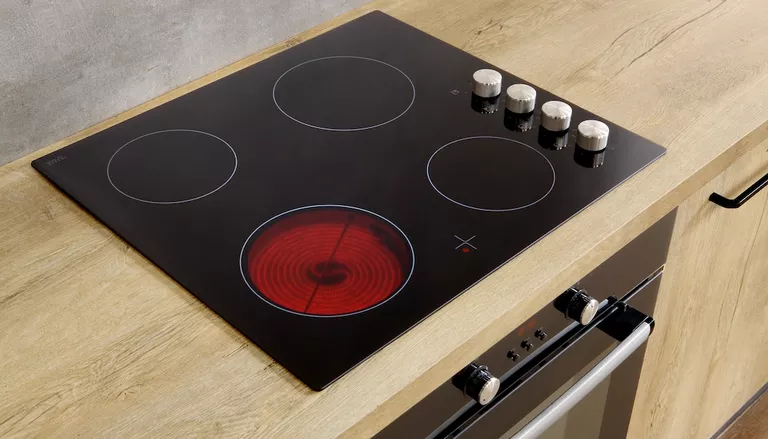Find local pros for your project
Tell us what you’re looking for and we’ll show you pros right for the job, with prices.
Updated
By Francesca Singer
If you've considered upgrading your cooktop or range, you might have heard about the efficiency of induction stoves. But how do they compare to their electric counterparts?
We're here to offer a little guidance to help you decide on the best fit for your kitchen. Read on for a full breakdown of the differences between induction stoves and electric stoves.
Let's start by comparing these two stove types across various factors:
Induction cooktops | Electric cooktops | |
Cost | Higher unit costs | Lower unit costs |
Energy efficiency | More efficient than electric and gas | Less efficient than induction |
Cookware compatibility | Requires ferrous cookware, like cast iron or stainless steel | Any cookware can be used, such as aluminum, copper, and glass |
Ease of cleaning | Easier to clean due to less burned-on residue | Cleaning is more difficult because food spills burn on |
Noise | May buzz at highest settings | Silent |
Residual heat | Almost none, cooktop is usually cool to the touch | Cooktop gets hot and stays hot for a long time, also heating the room |
Installation difficulty | Easy to install but may require a dedicated circuit | Easy to install |
 Unlike electric stoves, which heat cookware with an electric element, induction stoves use a magnetic field to generate heat directly in the pot or pan. Here are some key points to consider:
Unlike electric stoves, which heat cookware with an electric element, induction stoves use a magnetic field to generate heat directly in the pot or pan. Here are some key points to consider:
Electric stove overview.
 Electric stoves, unlike induction cookers, cook food by using a heating element. Let's explore their characteristics:
Electric stoves, unlike induction cookers, cook food by using a heating element. Let's explore their characteristics:
Related: How to clean an electric stove top with metal coils.
If you're still on the fence about which stove type to choose, the following steps can help you decide:
If you're happy with your current stove, replace it with a newer and better model. But what if you don't know what kind of stove you have?
Look at your stove's surface. Induction stoves have a smooth, glass-ceramic top. Electric stoves usually have exposed coils or radiant elements.
Not 100% sure whether your glass-top stove is electric or induction? Does the surface heat up and stay hot after you turn a burner off? If so, you have an electric stove.
If you're an avid chef who values precise temperature control and efficiency, an induction stove might be the better choice. If you're on a budget, cook infrequently, and don't mind slower heating times, electric might be more suitable.
Take a look at your existing pots and pans. If they're compatible with induction stoves (i.e., a magnet sticks to the bottom), you're one step closer to making the switch.
Do you have expensive, non-compatible cookware that you love and don't want to part with? Stick with an electric stove.
How much money are you willing to pay for a new stove? Once you've decided, research the induction and electric stove prices. In most cases, induction stoves tend to cost more. However, their long-term energy efficiency may save you money in the long run.
Do you have young children, or are you concerned about burns? If so, an induction stove's cool-to-the-touch surface may be a smarter choice for your household.
Making a decision about an induction vs. an electric stove ultimately comes down to your cooking preferences, budget, and existing cookware. Both options have their merits, so weigh the pros and cons before making your decision.
If you need help making a decision (and installing your new appliance), contact a pro near you. Download the Thumbtack app to see a list of top-rated appliance installation professionals in your area. Lean on their expertise when it comes to choosing an appliance and putting your stove together.
The primary difference is how they generate heat. Induction stoves use a magnetic field to heat cookware directly. Electric stoves use heating elements beneath the surface.
No, you need pots and pans that are compatible with induction cooking, which typically means they must be magnetic. You can easily test this with a magnet.
Yes, induction stoves are generally more energy-efficient because they heat the cookware directly, reducing heat loss.
Related: Which appliance is more energy-efficient?
Installation difficulty can vary, but it's typically not terribly different from installing an electric range. However, you may need a dedicated electrical circuit.
It's possible to retrofit your kitchen with an induction stove. However, it may involve some electrical work and possibly upgrading your cookware. For electrical work, it's highly recommended that you hire an electrician.
Induction stoves are generally safer for households with children. That's because the cooktop remains cool to the touch, reducing the risk of burns.
Tell us what you’re looking for and we’ll show you pros right for the job, with prices.